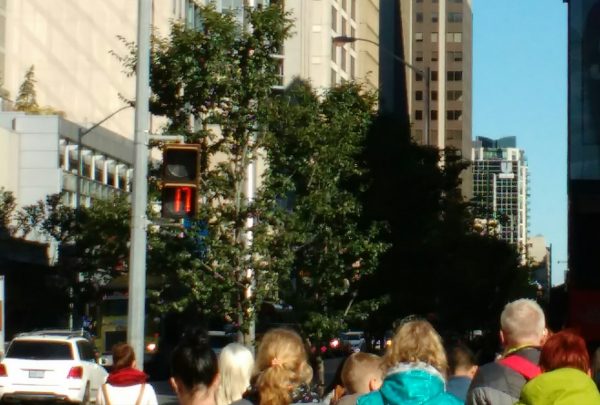The most important thing to realize about the pedestrian countdown signal is that it is only relevant to people who start crossing after the “flashing hand” has begun. In other words, its existence indicates that the City both assumes and accepts that pedestrians will start crossing during the flashing hand phase.
We are sometimes told that the countdown is there to help people who started crossing during the “walking man” phase know how much time they have. But in fact, by law, they do not need any help. Ontario’s Highway Traffic Act (HTA), section 144(28) specifically states that any pedestrian who starts crossing legally (i.e. with the walking man signal) has the right of way for however long it takes them to cross the road at their personal full speed — even if the light against them turns red.
Every pedestrian who lawfully enters a roadway in order to cross may continue the crossing as quickly as reasonably possible despite a change in the indication he or she is facing and, for purposes of the crossing, has the right of way over vehicles.
So the countdown is not relevant for people who start crossing with the walking man signal.
Why does it exist, then? The real but unspoken reason is to let people who might start crossing during the flashing hand phase judge whether they have enough time to cross. The installation of the countdowns was effectively an admission that the City does not expect pedestrians to obey the letter of the law (the HTA, 144(27), states that pedestrians must not start crossing on the flashing “don’t walk” signal).
Recent changes in City policy have in fact made it even more reasonable for people to start crossing during the countdown. In a effort to give people who move more slowly such as many seniors, people with mobility impairments, and parents with children more time to cross the street safely, the City has begun re-timing the countdowns so that they allow for a walking speed of 1.0 metres/second (down from the old 1.2 metres/second standard). That means that countdowns now give a very long time to cross indeed — and people who can move more quickly can easily cross safely after the countdown starts. At intersections with long intervals, it also means that the amount of time that the “walking man” shows has been reduced, so that there’s only a narrow window for pedestrians to start crossing during that phase.
The original goal of introducing pedestrian countdowns was explicitly to improve pedestrian safety. Studies had shown that, with a countdown, there were fewer pedestrians left exposed in the intersection after the light had turned (recall that, in the old days, when you saw a flashing hand you had no idea how much time you might have to cross). The countdown signals have never been about improving vehicle movements, contrary to some recent statements from the police.
I was a member of the Toronto Pedestrian Committee back in 2006 when the program was launched, and we explicitly asked about the law regarding not crossing against the flashing hand. The Toronto Police Services representative at the committee said that it was rarely enforced, and that they themselves could not recall an instance of it being enforced.
That’s changed. Now, we hear the mayor and police representatives recalling this once-obscure law in the media. As far as I can tell, the law was taken out of the deep freeze and dusted off after there was an outcry in the media about pedestrian safety following an unusual string of deaths in the winter of 2010. The response to this outcry about pedestrian safety was a police blitz that focused on “jaywalking” and the little-known countdown law. The effect was to focus attention on pedestrian behaviour, and away from driver behaviour and unsafe infrastructure issues (note that a report from the Medical Officer of Health (PDF) found that in 2/3 of collisions hitting pedestrians, the pedestrian had the right-of-way).
Earlier this month, New York City recognized the absurdity of the situation and changed its rules regarding pedestrian countdowns. Now, pedestrians are free to start crossing during the countdown, and are simply required to be clear of the intersection by the time the countdown stops. It’s up to them to judge if they can make it — which makes sense given the very different speeds at which different pedestrians move. Unfortunately, Toronto can’t make this change itself, as it it dependent on the province to change the HTA. But the City and the Toronto Police Service could, at least, go back to signalling that they are not going to worry about technicalities, and instead focus on what is important for safety, which is that pedestrians who start crossing during the countdown make sure they have cleared the intersection when the light changes.




10 comments
Used to be there were few if any pedestrian signals. People crossed during the GREEN light, ran quickly to the other side on the YELLOW light, and waited on the RED light.
Today, pedestrians have to wait for the walking stick man before crossing. UNLESS they either forgot to press the pedestrian button, or assumed that the lights will change because there was a countdown for the other crossing. Then they cross on the GREEN traffic light, because the pedestrian signal “seemed to be broken” or run across the RED to catch the bus because the signal didn’t change at the end of the countdown because “it was broken”.
In other parts of the world, there are “intelligent” signals. They get activated just by the presence of a human (without having to press a button). They can lengthen the pedestrian crossing if the pedestrian is taking “forever” to cross. They can cancel the pedestrian crossing signal if the pedestrian walks away or doesn’t cross.
Instead of spending 3 billion on a subway that goes one stop. Why dont we spend that money on truly modernizing our traffic management system, including the replacement of ALL signaled intersections. This will not only lead to better traffic movement throughout the city. But will also lead to fewer pedestrian deaths.
The whole idea of not crossing during the countdown phase is absurd. The light is green! Especially when one of the (bullshit) reasons given is to allow cars to turn without pedestrians being in the way. Imagine for a moment we had no pedestrian signals, and you see the light is green. You’re about to cross but wait! Someone tells you to be considerate of the cars who may want to turn and you should wait until the next green before you cross.
You would tell that person to get stuffed.
Thanks for this article.
My memory for these irritating countdowns was exactly as you’ve noted. To help pedestrians, not hinder them. I was really surprised to hear that police statement saying you couldn’t start to cross after the countdown started. I was sure the cop made a mistake. But no, they repeated it. Their arrogance towards pedestrians amazes me.
At my intersection with Bloor Street the walking man sign is lit for less than four seconds before switching to the numeric countdown of eighteen seconds. It is impossible to cross four lanes of traffic in four seconds. All of these signals are designed for the convenience of the automoble drivers and not the pedestrians.
I find it ironic that cars are allowed to enter and cross the intersection while pedestrian have the right of way turns, in particular right hand turns, should not be allowed while the countdown is on.
I think it was in Burlington where I saw pedestrian signals that started the countdown immediately, as soon as the walk signal lit. You’d know immediately how much time was left in the crossing without having to wait until the hand started flashing.
Should have a solid walking man with the green light, followed by a flashing walking man with the countdown with the green light, then a flashing hand on the yellow light, and then the solid hand on the red light. That’s how it should be.
Dylan
I was a member of the Toronto Pedestrian Committee when this item was first proposed (and passed by the TPC).
Transportation staff assured us prior to this motion being passed that there would be a “walk” display to identify the clearance interval and pedestrians were considered to be adults who would judge their walking time accordingly.
Somewhere along the line, Transportation staff ignored this original proposal by their own staff and implemented the flashing “don’t walk” signal.
This strongly suggests that pedestrians were seen as incompetent in judging both time and distance while simultaneously ensuring that the intersections were clear of pedestrian “obstructions” so that drivers would not be inconvenienced.
Here’s the excerpt from the Toronto Pedestrian Committee February 19, 2003 meeting:
(5) Flashing “Walk” Display (flashing white “walking man” to indicate the
pedestrian clearance interval in place of the flashing “don’t walk”) ;
(6) Far Side Pedestrian Count Down Timer (countdown timer indicates the
time left until the Don’t Walk display);
I trust this clarifies the issue.
Bill
As a driver, walker, and occasional cyclist, I prefer the simple walk/don’t walk signal. I obey the signals and the laws, and also use that rarest of commodities- common sense! I guarantee that can’t be said for about 75% of drivers, pedestrians or cyclists. I’d like to see some enforcement by the law at intersections, and between as well, as basically it’s a free-for-all at this point, and deaths are the result! Less griping about rights, more emphasis on responsibility!!!